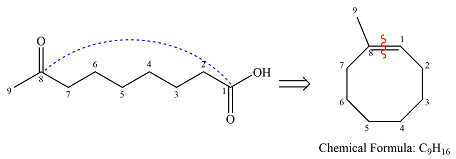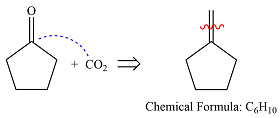
(a)
Interpretation:
The organic product of the given reaction is to be drawn.
Concept introduction:
Multiple bonds in
Answer to Problem 24.58P
The structure of the reactant in the given reaction is

Explanation of Solution
The given reaction is

Hot, concentrated permanganate (

Therefore, the structure of the reactant must be

The structure of the reactant was determined based on retrosynthetic analysis, the undoing of oxidative cleavage of a double bond.
(b)
Interpretation:
The organic product of the given reaction is to be drawn.
Concept introduction:
Multiple bonds in alkenes and alkynes are cleaved when treated with hot, concentrated permanganate in a basic solution in an oxidative cleavage reaction. Both carbons of the alkyne are oxidized in the process to carboxyl groups. The end carbon of a terminal alkyne is oxidized completely to carbon dioxide. The final functional group that is formed depends on the reaction conditions. The permanganate ion is added across the double bond in a way similar to the Diels-Alder reaction, a
Answer to Problem 24.58P
The structure of the reactant in the given reaction is

Explanation of Solution
The given reaction is

Hot, concentrated permanganate (

Therefore, the structure of the reactant must be

The structure of the reactant was determined based on retrosynthetic analysis, the undoing of oxidative cleavage of a double bond.
(c)
Interpretation:
The organic product of the given reaction is to be drawn.
Concept introduction:
Multiple bonds in alkenes are cleaved when treated with ozone in a reaction called ozonolysis. Both carbons of the alkene are oxidized in the process to carbonyl groups. Ozone adds across the double bond in a
Answer to Problem 24.58P
The structure of the reactant in the given reaction is

Explanation of Solution
The given reaction is

Ozonolysis will cleave the double bond in the reactant, oxidizing the two carbons to carbonyl groups. Therefore, the two carbonyl carbons in the products must have been joined by a double bond in the reactant.

Therefore, the structure of the reactant must be

The structure of the reactant was determined based on retrosynthetic analysis, the undoing of oxidative cleavage of a double bond.
(d)
Interpretation:
The organic product of the given reaction is to be drawn.
Concept introduction:
Multiple bonds in alkenes are cleaved when treated with ozone in a reaction called ozonolysis. Both carbons of the alkene are oxidized in the process to carbonyl groups. Ozone adds across the double bond in a
Answer to Problem 24.58P
The structures of the reactant in the given reaction is
![]()
Explanation of Solution
The given reaction is

Ozonolysis will cleave a double bond in the reactant to oxidize the two carbons to carbonyl groups. If the product is an aldehyde, it is oxidized to the carboxylic acid group by

Therefore, the structure of the reactant must be
![]()
The structure of the reactant was determined based on retrosynthetic analysis, the undoing of oxidative cleavage of a double bond.
Want to see more full solutions like this?
Chapter 24 Solutions
ORGANIC CHEMISTRY:PRIN...(PB)-W/ACCESS
 ChemistryChemistryISBN:9781305957404Author:Steven S. Zumdahl, Susan A. Zumdahl, Donald J. DeCostePublisher:Cengage Learning
ChemistryChemistryISBN:9781305957404Author:Steven S. Zumdahl, Susan A. Zumdahl, Donald J. DeCostePublisher:Cengage Learning ChemistryChemistryISBN:9781259911156Author:Raymond Chang Dr., Jason Overby ProfessorPublisher:McGraw-Hill Education
ChemistryChemistryISBN:9781259911156Author:Raymond Chang Dr., Jason Overby ProfessorPublisher:McGraw-Hill Education Principles of Instrumental AnalysisChemistryISBN:9781305577213Author:Douglas A. Skoog, F. James Holler, Stanley R. CrouchPublisher:Cengage Learning
Principles of Instrumental AnalysisChemistryISBN:9781305577213Author:Douglas A. Skoog, F. James Holler, Stanley R. CrouchPublisher:Cengage Learning Organic ChemistryChemistryISBN:9780078021558Author:Janice Gorzynski Smith Dr.Publisher:McGraw-Hill Education
Organic ChemistryChemistryISBN:9780078021558Author:Janice Gorzynski Smith Dr.Publisher:McGraw-Hill Education Chemistry: Principles and ReactionsChemistryISBN:9781305079373Author:William L. Masterton, Cecile N. HurleyPublisher:Cengage Learning
Chemistry: Principles and ReactionsChemistryISBN:9781305079373Author:William L. Masterton, Cecile N. HurleyPublisher:Cengage Learning Elementary Principles of Chemical Processes, Bind...ChemistryISBN:9781118431221Author:Richard M. Felder, Ronald W. Rousseau, Lisa G. BullardPublisher:WILEY
Elementary Principles of Chemical Processes, Bind...ChemistryISBN:9781118431221Author:Richard M. Felder, Ronald W. Rousseau, Lisa G. BullardPublisher:WILEY





